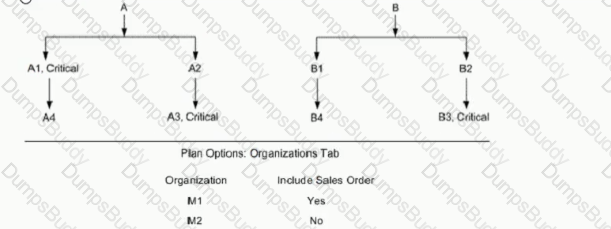Identify the three correct statements about the setups required to enable pegging within an ASCP plan.
Exhibit.

You define a Supply Chain plan of type "Manufacturing Plan." In the Plan Options Main tab, you select Planned Items as "Demand schedule items and all sales orders" and select the Include Critical Components check box.
The Exhibit shows Bills of Material for Items A and B. It also shows the settings for the Include Sales Order check box on the Plan Options Organizations tabbed page.
Item A has Demand Schedules and Sales Orders for Organizations Ml and M2. Item B has only Sales Orders for Organizations Ml and M2.
Which three statements are correct in the above plan scenario?
For Make Items, the time required to make the Item If you have all of the Buy Items In Inventory and have to make all Subassemblies and the Item Itself Is called______.
Identify the four correct features that Optimized plans automatically choose (on the basis of minimizing plan objective cost).
Your client is using Global Forecasts. The client's Planning Manager states that Sales Order consumption is not working correctly. Identify two possible causes.
Identify four exception messages that are most likely to appear In an unconstrained plan.
The planning engine provides the detailed bills of material (BOM) and Routing information associated with an Item from the Planner workbench.
You right-click and item in the Navigator and select BOM/Routing. The shortcut menu displays some options to further navigate to specific information.
Which two option are NOT displayed?